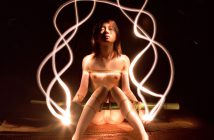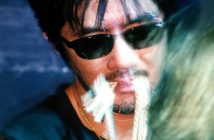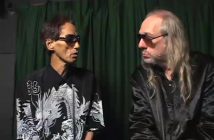As promised, the follow-up to Part I of the Osada Steve (長田スティーブ) interview which was first published in January.
I want to pick a bone with you and get your reaction: I think sophisticated Japanese rope technique is a relatively recent phenomenon. When I look at old black and white photos, the rope ties seem quite simple.
I fully agree that early bondage photos in Japan contain a lot of shoddy and outright silly rope work. However, we are talking about a time when Shibari started to come out of the closet and impishly seep into the print media. Do not forget that what you see in these photos might often be the work of some editor or reader. Even today, from a technical point of view I am not overly impressed by the level of rope work displayed in contemporary bondage mags. This is because the emphasis is mostly on creating erotic images where advanced bondage technique is taking a back seat.
According to Chiba Eizoh sensei, there are an estimated 2,000 amateur rope practitioners in Japan whose technique is much higher than what we are used to seeing in today’s media. These are people who mostly practice their craft in private, but easily out-tie some of the top professionals. The fact that the state-of-the-art of (visible) rope bondage in Japan has improved over the years, is essentially the result of the entire bondage print media industry having prospered and become more professional. So much so, that the industry today supports the livelihood of a number of rope artists. Of course, on an individual level each person’s tying skill is constantly improving with practice. So naturally, when you search publisher archives you will come across very simple bondages that were done by some of today’s celebrity Nawashi.
However, do not forget that prior to the dissemination of bondage imagery that first started with ukioye woodblock prints long before finding a market in the mass media, there was a time where rope bondage was a profession. I would say the state-of-the-art of rope work back then was much, much higher than what we see in Shibari today. So you could say between the disappearance of hobakujutsu/hojojutsu and the emergence of Shibari there was something of a black hole, a sort of Dark Age for rope bondage in Japan. So what you see in those old photos are the first steps at catching up and rediscovering/rebuilding an important part of traditional Japanese cultural heritage.
One other point of controversy: In another interview you mentioned that Western crucifixion imagery wouldn’t work in Japan. And yet, anime has a lot of it and there is a website in Japan specifically devoted to it. And, Toei churned out some movies with this type of imagery. Are you sure about this?
I should have been more precise when I used the term crucifixion to illustrate a point I was making. My answer was in response to a question whether I thought there was some influence from Western bondage artists on Japanese rope artists.In Shibari, as practiced on an expert level in Japan, you see recurring patterns that are based on a subset of highly codified historical and cultural roots. So what I meant was the bondage within, the actual ties on the body, not some person secured to some cross with ties that, technically speaking, any child could do. Now, anime artists aren’t necessarily known for their prowess in the art of Shibari. I suspect that the ties you are referring to are either very simple or outright impossible to do on a live person. As for certain Japanese movies showing people tied to a cross, nobody can deny a director the liberty of staging whatever modern or period scenes he chooses. But again, I wouldn’t classify the rope work in such movies as Shibari.
Let’s not forget that the Japan of old witnessed some heavy-handed persecution of Christians, and this unfortunate situation naturally lends itself to very graphical torture scenes with crucifixion. I might sound like a broken record, but you don’t need to call in a Shibari expert to tie someone to a cross.There is definitely some very cool rope bondage going on outside Japan. However, the patterns are different and do not mix with what we practice as Shibari. A Shibari expert in Japan is better off by drawing on hundreds of years of established patterns that will occupy a lifetime to master, so implementing ideas from Western bondage would be the last thing on his mind.
What do you most enjoy: Live shows, making videos, Studio SIX, teaching Shibari? Why is it your preference?
That’s a tough question. As I enjoy everything that has to do with rope. Each of these activities has its positive sides, and I guess the ideal is a healthy mix between them all.Of course, I need to reconcile my love for rope with the necessity of getting paid for what I do. This will often mean compromising and doing things that are less fun. I might be living the dream that other people have, but I can assure you that nothing comes from nothing. To get ahead in this business actually involves a lot of hard work.
Do you have any favorite models to work with and if so, why?
For the past few years, for every major live gig, I have exclusively partnered with Asagi Ageha. She has a huge following, so most people are actually coming to watch Asagi Ageha, not Osada Steve. This is perfect for me, as I can then concentrate on my rope work and stay out of sight as much as possible.For most other stuff I am constantly changing models, as that’s the only way to survive in this business.
Some big-name companies use actresses who have very little if any interest in SM. All of your models love bondage, don’t they?
I am fortunate to have a never-ending supply of young women who wish to be tied by me. This allows me the luxury of introducing a different model at my Kinbaku Live events at Studio SIX week after week. As Studio SIX in its present format is running since August, 2002, you can interpolate how many women have modeled for me to date. I continue to work with only those that are really into rope. Basically, I am breaking in each new sub at Studio SIX first, before using them for other types of work.On the other hand, if I’m hired by big-name companies, I’m mainly running into porn actresses. At times there can be up to 30 people on the set, so these gigs are all work with very little fun.
How are Japanese bondage girls different from Western bondage girls or are they? The reason I ask is because a European girl came over and performed with you. She was always looking at you. Japanese girls don’t seem to do this. They are also known for closing their eyes. Any comments?
You must be referring to the elusive Scarlet who lists her occupation as Puzzler. She has that ability to puzzle people. I think it’s the mysterious way she looks at you. One time, at Jail Tokyo, she came on stage when a guy in the front row was just about to light a cigarette. When the show was over he was still holding that unlit cigarette, jaw dropped.She was very easy to work with, and I managed to stay unpuzzled most of the time.Japanese subs don’t look you in the eyes. They tend to go inside themselves. I guess there are some cultural issues at work here.
Why no “safe words” in Japan?
I can only speculate as to why, but you are right that the concept of using safe words has yet to catch on in Japan. People here simply ask you to stop. The Top, at all times, is fully accountable for the well-being of the sub. Provided the Top is sensible enough, there are multiple ways of figuring out when a sub has had enough. Personally, I don’t even negotiate. So you could say my play is non-negotiable. But then again, I am not an edge player or do any particularly dangerous or painful stuff.
When the people of hogtied.com and waterbondage.com came over to shoot with me, they were asking what I would do if my model wanted to opt out of a scene. So for the first time in my life, in order to satisfy their concern for safety, we arranged for a safe word. But don’t get me wrong! I am not advocating that safe words be abolished.
What activities are you currently engaged in? Is there anything on the horizon you can tell us about? 
I am trying to cut down the number of live shows to about 200 a year and focus more on video work. I also want to make more time for study. I mean, it’s not like one moment I’m holding a piece of rope and suddenly some idea for a super cool bondage pops out of my head. Of course, I could go on for years and just improvise, but the result would mostly be crap. For the foreseeable future I want to continue on a path of serious study. I have barely scratched the surface of what Shibari has in store for me.
Your photos are incredible, especially those light-drawn ones. You do a lot of video work but what about getting some of these photos published in the mags?
I stopped taking photos several years ago. So these are not my photos, only the rope work was done by me. The light-painting series are collaborations with Z. Maitri who visits me in Japan once in a while. Most people think these photos involve some computer manipulation.Several of these photos have found their way into foreign publications. But for Japanese audiences though they are lacking an erotic element that caters to the specific tastes of Kinbaku enthusiasts. People here want to be served beauty in suffering, a special facial expression between pain, shame and ecstasy.
I am a huge fan of Saotome Hiromi. You know her and have worked with her. What can you tell us about her? What is she like? What was it like to work with her?
Saotome Hiromi is a celebrity in the Japanese SM world. For many years she used to be the main show partner of Osada Eikichi, and to this day she continues a very successful solo career.I have only worked with her once when I produced a video to commemorate what would have been Osada sensei’s 80th birthday. She is absolutely professional. Read: She is one hundred percent stage and camera aware, yet all her reactions are genuine. I will shortly produce another video with her for JapanBondage.tv featuring her seppuku (ritual suicide) act.
While Westerners may have difficulties in understanding the merits of seppuku within the SM context, there is a fair number of Japanese that appreciate this genre. Japanese audiences generally have a face fetish. Once captured in rope, a woman’s face will change. And there is a similarity in facial expression when a Japanese woman climaxes or experiences the moment of death in ritual suicide.
You have been quite vocal concerning your feelings about bondage in the West. As I understand it, you’re not criticizing Western bondage. You just don’t like it when people who have no clue pass themselves off as Shibari “masters”. Do I have this right?
Yes, you do have it right. I love rope, and I do appreciate all styles of bondage, and I especially appreciate anybody’s effort to provide quality time to his rope partners. If the ties look nice without causing discomfort, I do appreciate that even more. What I don’t appreciate are people who classify their ties as Shibari, when in fact their ties are reverse-engineered Japanese-inspired bondages. In my book, someone who has never been to Japan, someone who has never directly studied under any genuine Japanese Shibari practitioner (read: someone with a traceable lineage to one of the Shibari dynasties in Japan), someone who takes his knowledge from a picture on the Internet, or from watching a Japanese SM porn video, or from having attended a workshop that was mislabeled as a Shibari lecture, would be better off not making a fool of himself. Such a person should better describe his bondage in English words, perhaps as Japanese-inspired bondage, with emphasis on inspired.
Some of the larger Internet rope groups are today infested with people who actually believe they are Nawashi. What may have started as troll bait has now taken on its own life, and as a result you have people out there bent on reducing the art of Shibari to the making of a pretzel. There are even attempts by some Westerners to change the meaning of certain Shibari terminology in a sort of cookie-cutter effort to retroactively justify their own history of ignorance about the subject matter. When you read discussions about whether a Korean could make a decent burrito with rice instead of wheat, and whether you could then still call it a Mexican burrito and if you could, then THEREFORE you too (and your cousin’s neighbor) have the right to call your bondage Shibari, you know what direction Shibari is taking in the West.
How did you get started at Jail and do you still perform there?
I first met the owner (Oda Hisashi sensei) of the nationwide chain of Jail clubs at Studio SIX when Osada Eikichi sensei was still alive and performing. Oda sensei is an extremely wealthy businessman based in Osaka. When he moved into Tokyo to first establish Roppongi Jail and later Jail Tokyo, I started to perform there weekly for about two years.
Oda sensei has taught me a lot, and I am extremely grateful to him for giving me the opportunity to break out of Studio SIX and perform on a larger stage. When I got my first gig of 80 shows at Kujo OS in Osaka, Oda sensei took time to coach me for strip theater shows. Oda sensei knows everything about shows. He has an excellent grasp of what it is that an audience expects to see. I am also a great fan and admirer of Oda sensei’s Kinbaku. I still drop by at Jail Tokyo, and more often than not, end up doing impromptu performances there. Oda sensei is like a godfather to me.
As I understand it, you have a regular gig at Randa Mai‘s club. Randa Mai is one of the most famous Nawashi in Japan and has been on national TV. How did you meet and what kind of relationship do you have?
I first met Randa Mai at the Mistress Bar around the time when Osada Eikichi was still performing there. For a period of time I then extensively covered Randa Mai’s shows through photography.
My regular gigs at Ranbukan (Randa Mai’s place) started in 2004. My nights over there are popular with couples and single women, because after a little teaser show I am supposed to (and gladly will) tie up female customers well into the wee hours. Randa-san is a very busy person, so we only bump into each other a few times a year. We sometimes share the same stage, and just the other day we starred in the same Attackers video. He also collaborates with my JapanBondage.tv website where I stream some of his movies from his own label.
How are your classes set up for teaching Shibari techniques? Can someone live in your home if they study with you full-time as in the classic uchi-deshi arrangement?
I don’t do workshops, but am exclusively teaching one-on-one. I have a couple of regular students that live in Japan, and I am also offering classes to short-term visitors. The latter are either people who come to Japan on business and only have time for a few lessons, or people who visit me for several weeks with the specific goal of intensive study.
Fortunately all ties can be broken down into distinct building blocks. So there are no complicated techniques, only simple techniques in combination. This makes systematic teaching (and therefore study) relatively easy.There is a distinction between student and deshi. A student is someone who receives a certain amount of lessons in exchange for a certain amount of financial remuneration. A deshi, on the other hand, is someone who sticks around for years, doing chores, and generally assists his sensei and in return will be able to gain much more than just knowledge about the technical aspects of Shibari. Perhaps I should mention that not every student or deshi necessarily seeks exposure or fame. Most people will study for one simple reason: Because they love rope.As for me accepting an uchi-deshi (live-in disciple), I do allow visiting students to crash out at my dojo, but I can’t imagine anybody shacking up with me in my home. I am a very private person, and I need a lot of private time and private space.
Who is the most interesting person you’ve met in Japan? 
Through my journalistic work in the past I have met with, interviewed and/or photographed quite a few people. Among them the Dalai Lama, the late prime minister Obuchi, yokozuna Konishiki and yokozuna Akebono, maverick photographer Nobuyoshi Araki, ninja great, grandmaster Masaaki Hatsumi, pro wrestler Jesse Ventura (also ex-governor of Minnesota), Dr. Floppy (Yoshiro Nakamatsu, who has over 3,000 inventions to his name) and other luminaries from business and commerce, sports, politics, and the arts. But these were all brief encounters.
On the other hand, I have met two people who struck my soul. One was Osada Eikichi, and it happened, I think, when I must have pleased or amused him, and he looked right into my eyes. That look he gave me then went right inside me, and at the same time I could see inside him. It was as though, for a brief moment in time, we were one. It was a very happy moment that I will never forget.
The other person was Akechi Denki, and it happened when I met him the first time. I had been taking photos of his performance at the Mistress Bar, and afterwards joined a get-together at the Master’s Bar (one floor below). It was there that Akechi sensei gave me that long gaze with a kind smile and looked right inside me. This was more like if Destiny came looking for you, and you know you will be all right. I will never forget that moment either.
That wraps up Part II of the interview with Osada Steve, a man who has a unique knowledge of, and insight into, the elusive and mysterious world of Shibari in Japan. I will be talking with Steve about a lot of things in the future and will post the results here. Check back often. You won’t want to miss a word.
KabukiJoe




1 Comment
Hallo KabukiJoe and OsadaSteve,
that is a great interview and as always packed with many good informations. Keep on the good work and I am glad to come to Tokyo in June.
Have fun and grab the ropes,
Matthias